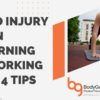As the weather turns warmer and warmer, for many people that means one thing; more and more gardening and yard work.
Anyone who has spent an entire afternoon in their garden or working in their yard knows how physically demanding keeping a clean and healthy yard is. However, research has shown that there are multiple physiological benefits to gardening as well; including stress relief.
Although yard work is a physically demanding chore, it is rarely approached as an individual’s ‘work-out’ for the day. Rarely have I seen, or have I had patients tell me about warming up or cooling prior down to gardening or mowing the grass. I hear how that spending an hour in their vegetable garden or mowing the lawn set off their low back or hip or shoulder pain. If we changed our mindset of gardening and yard-work to that of a work-out, we could drastically decrease or even eliminate the negative side effects (pain). A comparative study in Environmental Health (2010) by Van Den Berg et al, showcased “consistent with the notion that having an allotment garden may promote an active lifestyle and contribute to healthy aging.”
The following will be a guide to everyone to follow the next time they are heading out of the house to enjoy the sun in their yard and get some good exercise in.
1) Warm-up; it is essential to get your body prepared for the rigorous demands of gardening and yard work. A brisk 5-10-minute walk around the house or in the yard can suffice to get your blood flowing and muscles warmed. If you have any previous aches/pain or stiffness’s it is essential to perform your Physical Therapy Home Exercise Program prior to heading out into the yard.
2) Gather all the right tools. As in any job, if you do not have the right tools, the job becomes that much more demanding in both time but also physically rigor.
3) Keep an eye on your body mechanics. It is essential to keep good posture while working the yard. The more bending over that is required on the job, the more important that using the right body mechanics is key. Avoid excessive forward bending at the trunk; utilize the strength of your legs to perform a lunge or squat to do your heavy lifting.
-If you are unable to squat, try kneeling. You may also utilize a foam pad to kneel on to take some stress off your knees.
-If unable to squat or kneel for an extended time. Try to perform in a seated position. Utilize a small chair or bench, or even an unused heavy duty plantar will suffice.
–When mowing the lawn, make sure that your shoulders are relaxed (away from you ears), and your back is flat (should be able to rest a pole from the back of your head to your tailbone). Also propel the mower with your legs, to maintain a forward lean from the ankles to your head.
4) As with all physically demanding activities, stay hydrated! It is key to stay hydrated with water, sports drinks, and iced teas to avoid side effects of dehydration; this will also decrease your soreness the rest of the day.
5) Stop any activities that cause you pain. Your body is trying to tell you something is wrong. If it goes away quickly, try again, but if the pain comes back or persists, schedule an appointment with a physical therapist to assess the issue.
6) Finally, cool-down. A nice 5-minute walk around the yard to review all your hard work. Then end with some nice easy stretching to reduce your evening stiffness and soreness that will ensue.
Authored By: Brad Murison PT, MPT
If you liked this article please give us feedback and join the conversation. We would love to hear your suggestions on other science, anatomy, or movement topics you’d like to learn more about! Find us on Facebook, Instagram, and Twitter @BodyGearsPT.






